An Analysis of Apple Inc.'s Supply Chain Management and Revenue
VerifiedAdded on 2020/03/16
|17
|4257
|212
Report
AI Summary
This report provides a detailed analysis of Apple Inc.'s supply chain management, focusing on its operational structure, sourcing, manufacturing, and distribution processes. The report examines the company's competitive landscape, highlighting key competitors like Samsung and the impact of emerging smartphone manufacturers. It delves into the causes of Apple's revenue decline, including slowing iPhone sales, market saturation, currency fluctuations, and increasing competition. Customer requirements, such as the demand for complete solutions, product variety, and consistent performance, are also explored. The report assesses Apple's competitive advantages and offers recommendations for improvement, concluding with an overview of the company's current challenges and future prospects. The report emphasizes the importance of adapting to changing market dynamics and meeting evolving customer needs in the technology sector.
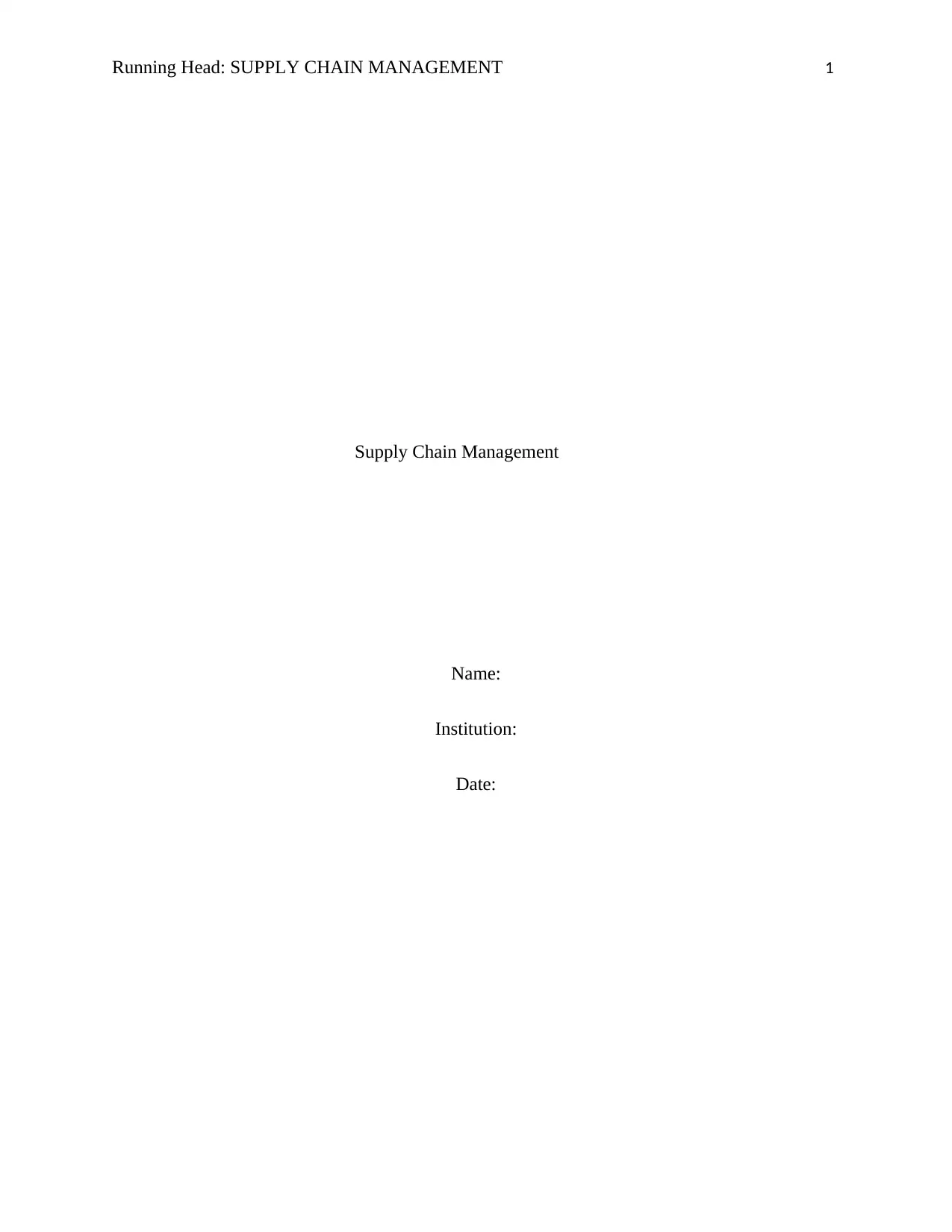
Running Head: SUPPLY CHAIN MANAGEMENT 1
Supply Chain Management
Name:
Institution:
Date:
Supply Chain Management
Name:
Institution:
Date:
Paraphrase This Document
Need a fresh take? Get an instant paraphrase of this document with our AI Paraphraser
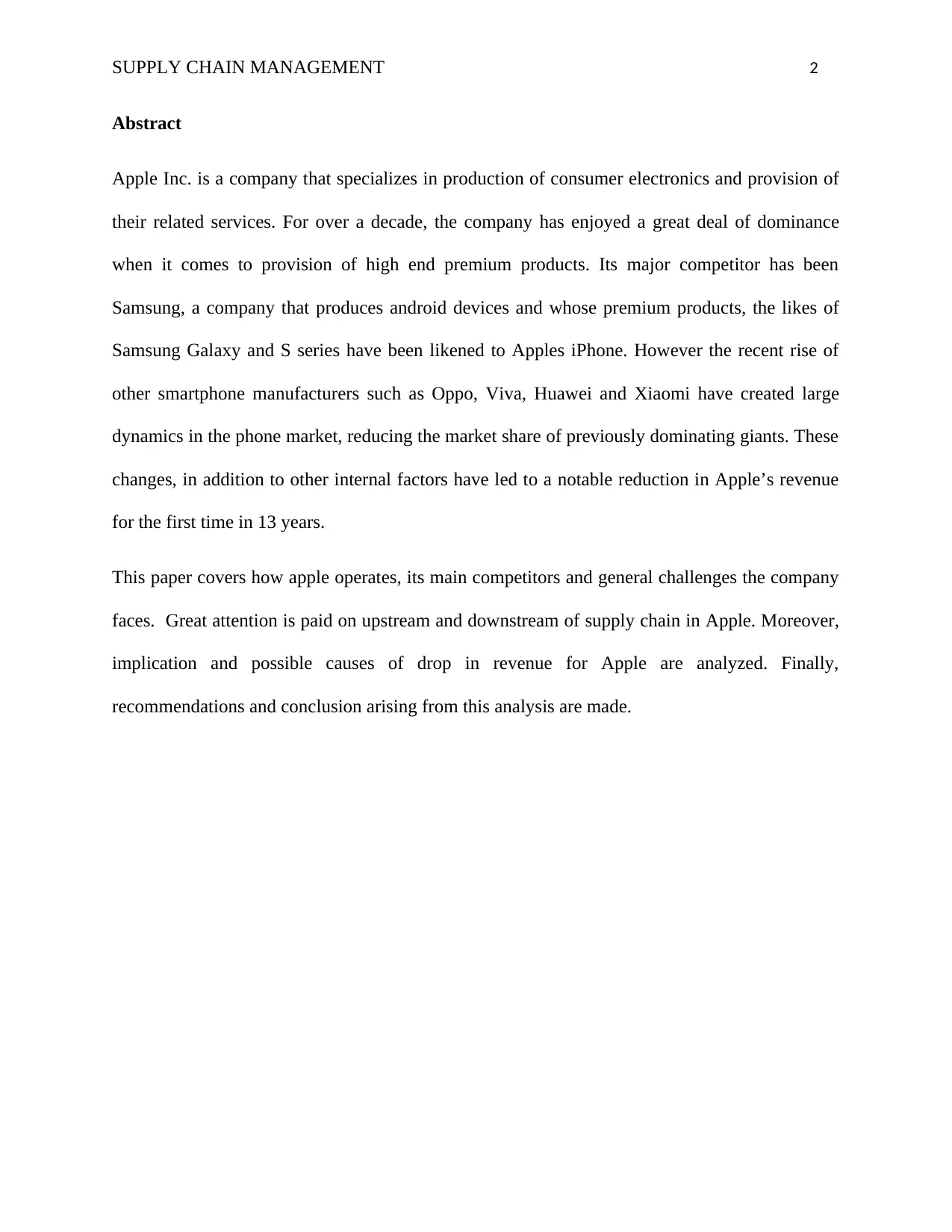
SUPPLY CHAIN MANAGEMENT 2
Abstract
Apple Inc. is a company that specializes in production of consumer electronics and provision of
their related services. For over a decade, the company has enjoyed a great deal of dominance
when it comes to provision of high end premium products. Its major competitor has been
Samsung, a company that produces android devices and whose premium products, the likes of
Samsung Galaxy and S series have been likened to Apples iPhone. However the recent rise of
other smartphone manufacturers such as Oppo, Viva, Huawei and Xiaomi have created large
dynamics in the phone market, reducing the market share of previously dominating giants. These
changes, in addition to other internal factors have led to a notable reduction in Apple’s revenue
for the first time in 13 years.
This paper covers how apple operates, its main competitors and general challenges the company
faces. Great attention is paid on upstream and downstream of supply chain in Apple. Moreover,
implication and possible causes of drop in revenue for Apple are analyzed. Finally,
recommendations and conclusion arising from this analysis are made.
Abstract
Apple Inc. is a company that specializes in production of consumer electronics and provision of
their related services. For over a decade, the company has enjoyed a great deal of dominance
when it comes to provision of high end premium products. Its major competitor has been
Samsung, a company that produces android devices and whose premium products, the likes of
Samsung Galaxy and S series have been likened to Apples iPhone. However the recent rise of
other smartphone manufacturers such as Oppo, Viva, Huawei and Xiaomi have created large
dynamics in the phone market, reducing the market share of previously dominating giants. These
changes, in addition to other internal factors have led to a notable reduction in Apple’s revenue
for the first time in 13 years.
This paper covers how apple operates, its main competitors and general challenges the company
faces. Great attention is paid on upstream and downstream of supply chain in Apple. Moreover,
implication and possible causes of drop in revenue for Apple are analyzed. Finally,
recommendations and conclusion arising from this analysis are made.
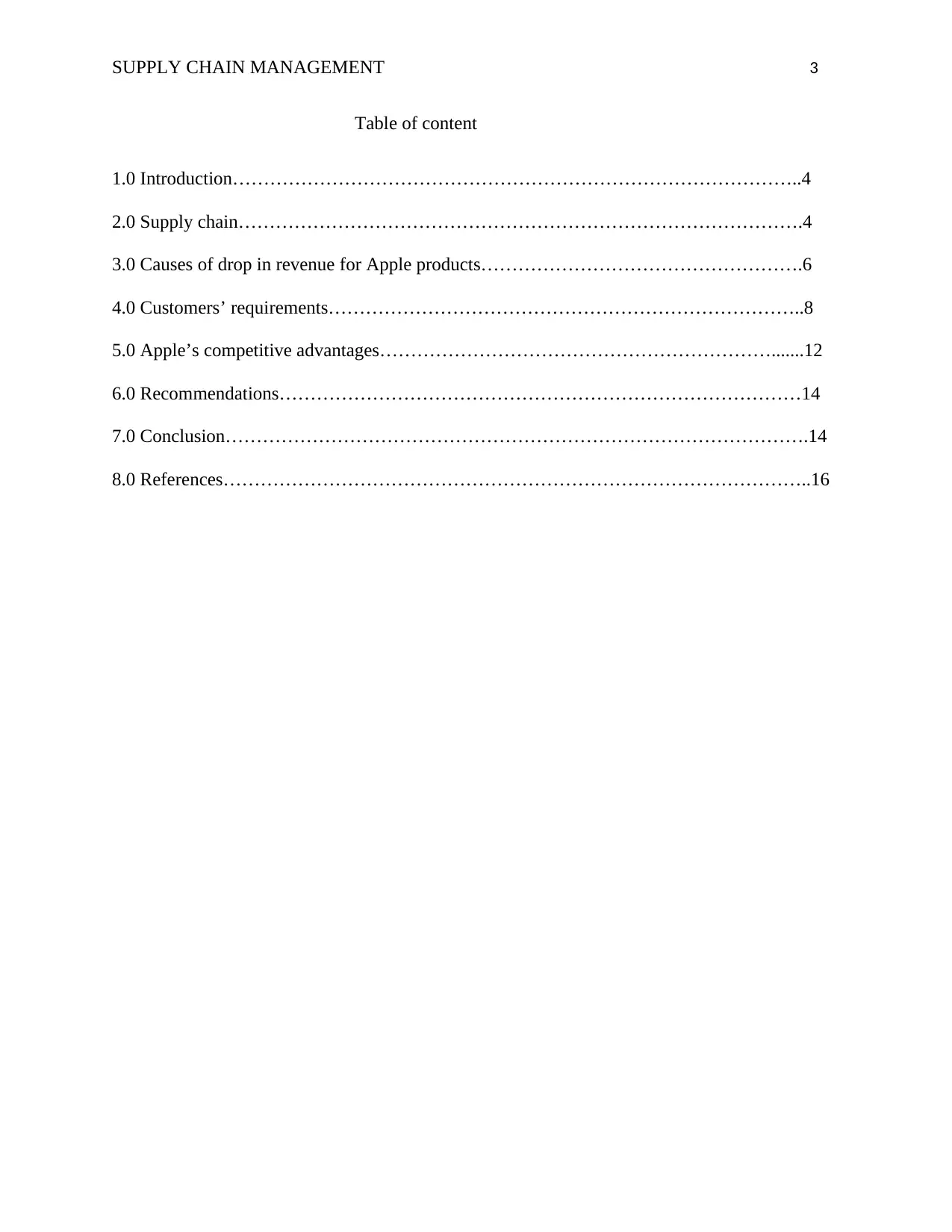
SUPPLY CHAIN MANAGEMENT 3
Table of content
1.0 Introduction………………………………………………………………………………..4
2.0 Supply chain……………………………………………………………………………….4
3.0 Causes of drop in revenue for Apple products…………………………………………….6
4.0 Customers’ requirements…………………………………………………………………..8
5.0 Apple’s competitive advantages……………………………………………………….......12
6.0 Recommendations…………………………………………………………………………14
7.0 Conclusion………………………………………………………………………………….14
8.0 References…………………………………………………………………………………..16
Table of content
1.0 Introduction………………………………………………………………………………..4
2.0 Supply chain……………………………………………………………………………….4
3.0 Causes of drop in revenue for Apple products…………………………………………….6
4.0 Customers’ requirements…………………………………………………………………..8
5.0 Apple’s competitive advantages……………………………………………………….......12
6.0 Recommendations…………………………………………………………………………14
7.0 Conclusion………………………………………………………………………………….14
8.0 References…………………………………………………………………………………..16
⊘ This is a preview!⊘
Do you want full access?
Subscribe today to unlock all pages.

Trusted by 1+ million students worldwide
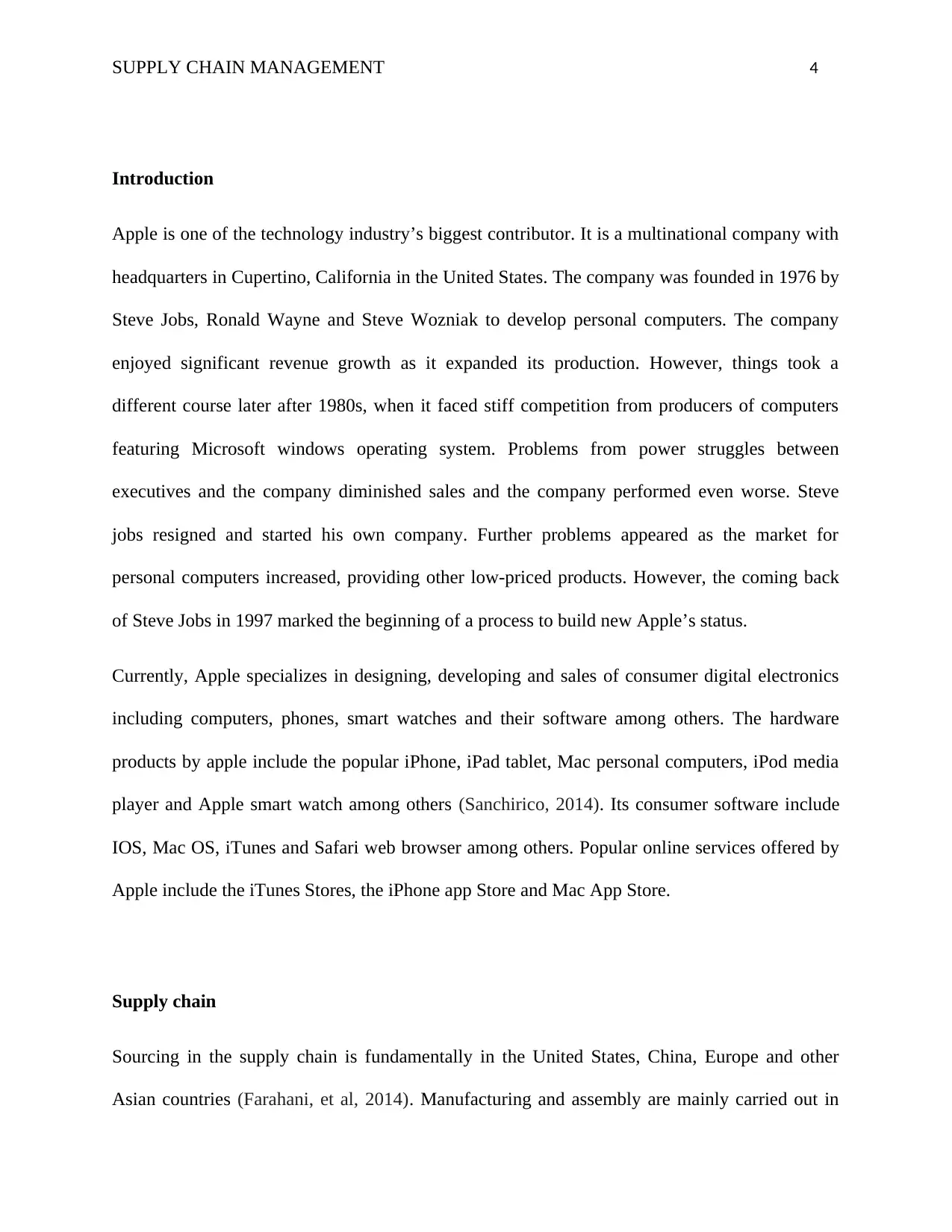
SUPPLY CHAIN MANAGEMENT 4
Introduction
Apple is one of the technology industry’s biggest contributor. It is a multinational company with
headquarters in Cupertino, California in the United States. The company was founded in 1976 by
Steve Jobs, Ronald Wayne and Steve Wozniak to develop personal computers. The company
enjoyed significant revenue growth as it expanded its production. However, things took a
different course later after 1980s, when it faced stiff competition from producers of computers
featuring Microsoft windows operating system. Problems from power struggles between
executives and the company diminished sales and the company performed even worse. Steve
jobs resigned and started his own company. Further problems appeared as the market for
personal computers increased, providing other low-priced products. However, the coming back
of Steve Jobs in 1997 marked the beginning of a process to build new Apple’s status.
Currently, Apple specializes in designing, developing and sales of consumer digital electronics
including computers, phones, smart watches and their software among others. The hardware
products by apple include the popular iPhone, iPad tablet, Mac personal computers, iPod media
player and Apple smart watch among others (Sanchirico, 2014). Its consumer software include
IOS, Mac OS, iTunes and Safari web browser among others. Popular online services offered by
Apple include the iTunes Stores, the iPhone app Store and Mac App Store.
Supply chain
Sourcing in the supply chain is fundamentally in the United States, China, Europe and other
Asian countries (Farahani, et al, 2014). Manufacturing and assembly are mainly carried out in
Introduction
Apple is one of the technology industry’s biggest contributor. It is a multinational company with
headquarters in Cupertino, California in the United States. The company was founded in 1976 by
Steve Jobs, Ronald Wayne and Steve Wozniak to develop personal computers. The company
enjoyed significant revenue growth as it expanded its production. However, things took a
different course later after 1980s, when it faced stiff competition from producers of computers
featuring Microsoft windows operating system. Problems from power struggles between
executives and the company diminished sales and the company performed even worse. Steve
jobs resigned and started his own company. Further problems appeared as the market for
personal computers increased, providing other low-priced products. However, the coming back
of Steve Jobs in 1997 marked the beginning of a process to build new Apple’s status.
Currently, Apple specializes in designing, developing and sales of consumer digital electronics
including computers, phones, smart watches and their software among others. The hardware
products by apple include the popular iPhone, iPad tablet, Mac personal computers, iPod media
player and Apple smart watch among others (Sanchirico, 2014). Its consumer software include
IOS, Mac OS, iTunes and Safari web browser among others. Popular online services offered by
Apple include the iTunes Stores, the iPhone app Store and Mac App Store.
Supply chain
Sourcing in the supply chain is fundamentally in the United States, China, Europe and other
Asian countries (Farahani, et al, 2014). Manufacturing and assembly are mainly carried out in
Paraphrase This Document
Need a fresh take? Get an instant paraphrase of this document with our AI Paraphraser
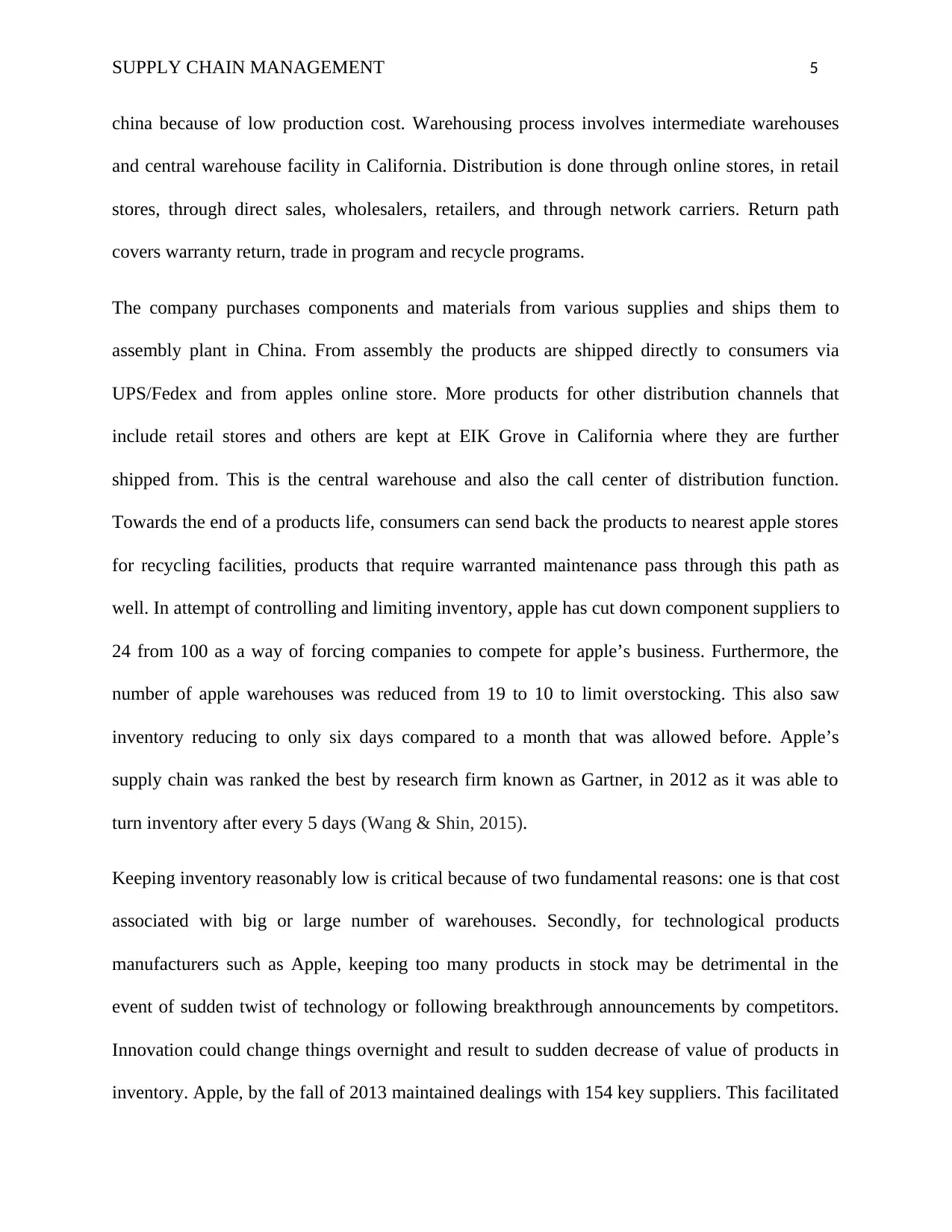
SUPPLY CHAIN MANAGEMENT 5
china because of low production cost. Warehousing process involves intermediate warehouses
and central warehouse facility in California. Distribution is done through online stores, in retail
stores, through direct sales, wholesalers, retailers, and through network carriers. Return path
covers warranty return, trade in program and recycle programs.
The company purchases components and materials from various supplies and ships them to
assembly plant in China. From assembly the products are shipped directly to consumers via
UPS/Fedex and from apples online store. More products for other distribution channels that
include retail stores and others are kept at EIK Grove in California where they are further
shipped from. This is the central warehouse and also the call center of distribution function.
Towards the end of a products life, consumers can send back the products to nearest apple stores
for recycling facilities, products that require warranted maintenance pass through this path as
well. In attempt of controlling and limiting inventory, apple has cut down component suppliers to
24 from 100 as a way of forcing companies to compete for apple’s business. Furthermore, the
number of apple warehouses was reduced from 19 to 10 to limit overstocking. This also saw
inventory reducing to only six days compared to a month that was allowed before. Apple’s
supply chain was ranked the best by research firm known as Gartner, in 2012 as it was able to
turn inventory after every 5 days (Wang & Shin, 2015).
Keeping inventory reasonably low is critical because of two fundamental reasons: one is that cost
associated with big or large number of warehouses. Secondly, for technological products
manufacturers such as Apple, keeping too many products in stock may be detrimental in the
event of sudden twist of technology or following breakthrough announcements by competitors.
Innovation could change things overnight and result to sudden decrease of value of products in
inventory. Apple, by the fall of 2013 maintained dealings with 154 key suppliers. This facilitated
china because of low production cost. Warehousing process involves intermediate warehouses
and central warehouse facility in California. Distribution is done through online stores, in retail
stores, through direct sales, wholesalers, retailers, and through network carriers. Return path
covers warranty return, trade in program and recycle programs.
The company purchases components and materials from various supplies and ships them to
assembly plant in China. From assembly the products are shipped directly to consumers via
UPS/Fedex and from apples online store. More products for other distribution channels that
include retail stores and others are kept at EIK Grove in California where they are further
shipped from. This is the central warehouse and also the call center of distribution function.
Towards the end of a products life, consumers can send back the products to nearest apple stores
for recycling facilities, products that require warranted maintenance pass through this path as
well. In attempt of controlling and limiting inventory, apple has cut down component suppliers to
24 from 100 as a way of forcing companies to compete for apple’s business. Furthermore, the
number of apple warehouses was reduced from 19 to 10 to limit overstocking. This also saw
inventory reducing to only six days compared to a month that was allowed before. Apple’s
supply chain was ranked the best by research firm known as Gartner, in 2012 as it was able to
turn inventory after every 5 days (Wang & Shin, 2015).
Keeping inventory reasonably low is critical because of two fundamental reasons: one is that cost
associated with big or large number of warehouses. Secondly, for technological products
manufacturers such as Apple, keeping too many products in stock may be detrimental in the
event of sudden twist of technology or following breakthrough announcements by competitors.
Innovation could change things overnight and result to sudden decrease of value of products in
inventory. Apple, by the fall of 2013 maintained dealings with 154 key suppliers. This facilitated
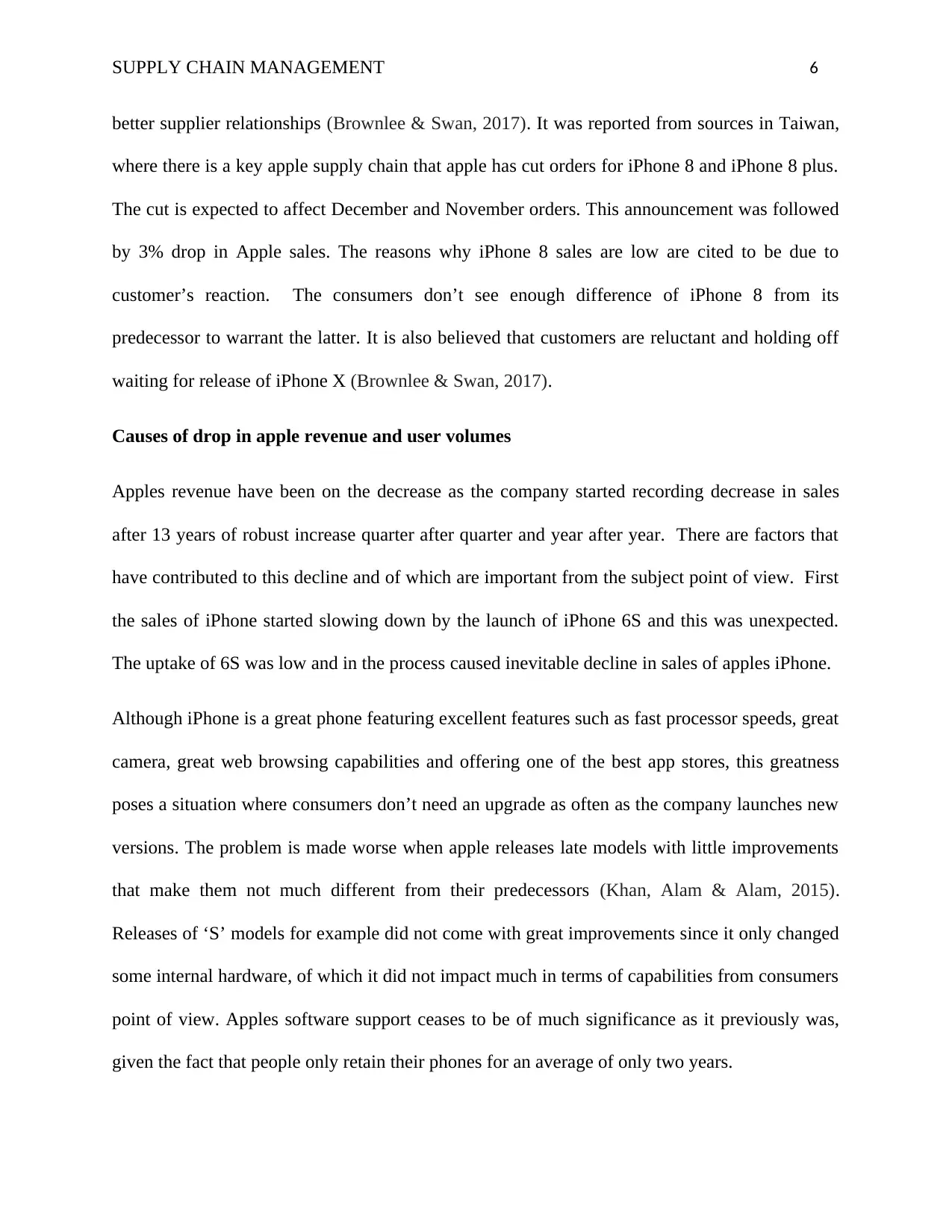
SUPPLY CHAIN MANAGEMENT 6
better supplier relationships (Brownlee & Swan, 2017). It was reported from sources in Taiwan,
where there is a key apple supply chain that apple has cut orders for iPhone 8 and iPhone 8 plus.
The cut is expected to affect December and November orders. This announcement was followed
by 3% drop in Apple sales. The reasons why iPhone 8 sales are low are cited to be due to
customer’s reaction. The consumers don’t see enough difference of iPhone 8 from its
predecessor to warrant the latter. It is also believed that customers are reluctant and holding off
waiting for release of iPhone X (Brownlee & Swan, 2017).
Causes of drop in apple revenue and user volumes
Apples revenue have been on the decrease as the company started recording decrease in sales
after 13 years of robust increase quarter after quarter and year after year. There are factors that
have contributed to this decline and of which are important from the subject point of view. First
the sales of iPhone started slowing down by the launch of iPhone 6S and this was unexpected.
The uptake of 6S was low and in the process caused inevitable decline in sales of apples iPhone.
Although iPhone is a great phone featuring excellent features such as fast processor speeds, great
camera, great web browsing capabilities and offering one of the best app stores, this greatness
poses a situation where consumers don’t need an upgrade as often as the company launches new
versions. The problem is made worse when apple releases late models with little improvements
that make them not much different from their predecessors (Khan, Alam & Alam, 2015).
Releases of ‘S’ models for example did not come with great improvements since it only changed
some internal hardware, of which it did not impact much in terms of capabilities from consumers
point of view. Apples software support ceases to be of much significance as it previously was,
given the fact that people only retain their phones for an average of only two years.
better supplier relationships (Brownlee & Swan, 2017). It was reported from sources in Taiwan,
where there is a key apple supply chain that apple has cut orders for iPhone 8 and iPhone 8 plus.
The cut is expected to affect December and November orders. This announcement was followed
by 3% drop in Apple sales. The reasons why iPhone 8 sales are low are cited to be due to
customer’s reaction. The consumers don’t see enough difference of iPhone 8 from its
predecessor to warrant the latter. It is also believed that customers are reluctant and holding off
waiting for release of iPhone X (Brownlee & Swan, 2017).
Causes of drop in apple revenue and user volumes
Apples revenue have been on the decrease as the company started recording decrease in sales
after 13 years of robust increase quarter after quarter and year after year. There are factors that
have contributed to this decline and of which are important from the subject point of view. First
the sales of iPhone started slowing down by the launch of iPhone 6S and this was unexpected.
The uptake of 6S was low and in the process caused inevitable decline in sales of apples iPhone.
Although iPhone is a great phone featuring excellent features such as fast processor speeds, great
camera, great web browsing capabilities and offering one of the best app stores, this greatness
poses a situation where consumers don’t need an upgrade as often as the company launches new
versions. The problem is made worse when apple releases late models with little improvements
that make them not much different from their predecessors (Khan, Alam & Alam, 2015).
Releases of ‘S’ models for example did not come with great improvements since it only changed
some internal hardware, of which it did not impact much in terms of capabilities from consumers
point of view. Apples software support ceases to be of much significance as it previously was,
given the fact that people only retain their phones for an average of only two years.
⊘ This is a preview!⊘
Do you want full access?
Subscribe today to unlock all pages.

Trusted by 1+ million students worldwide
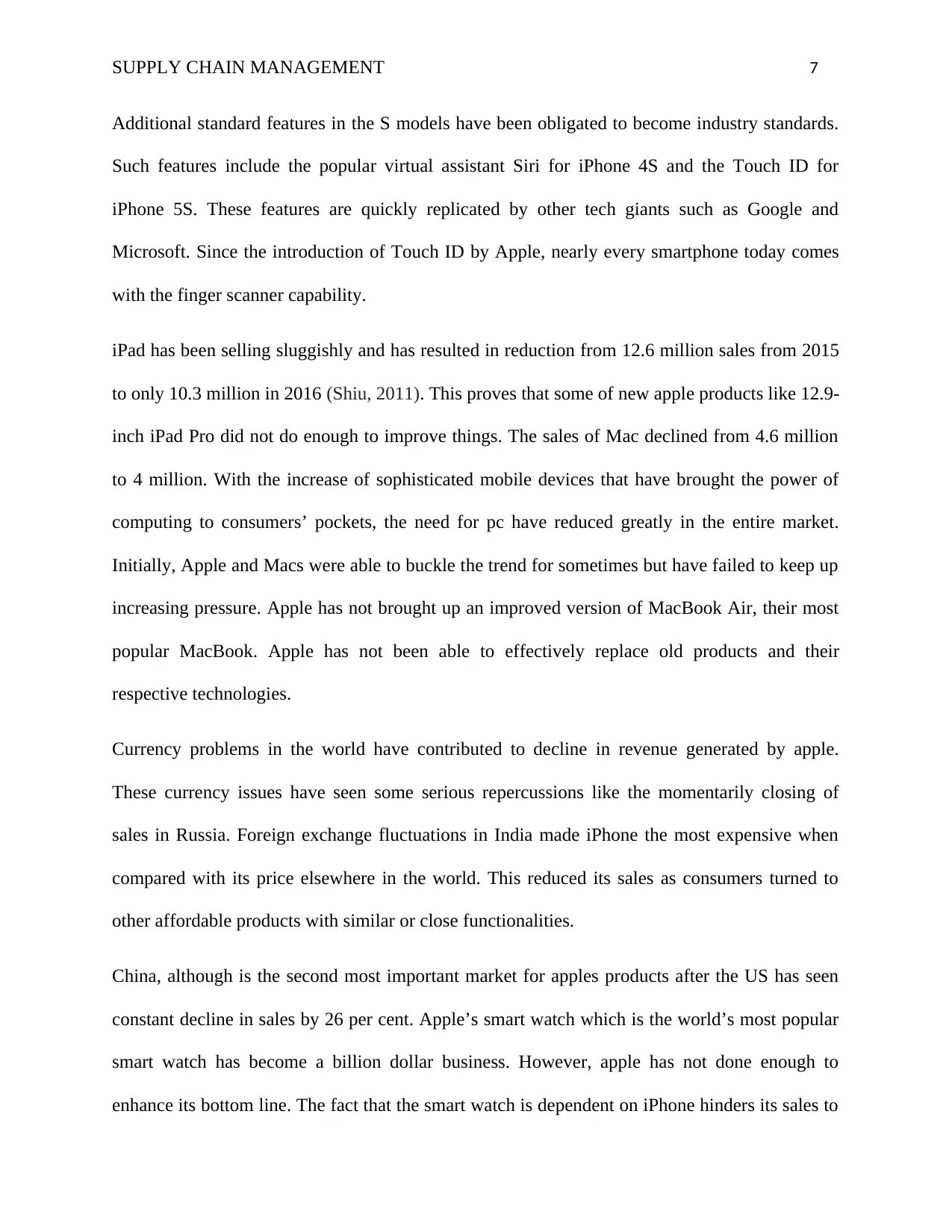
SUPPLY CHAIN MANAGEMENT 7
Additional standard features in the S models have been obligated to become industry standards.
Such features include the popular virtual assistant Siri for iPhone 4S and the Touch ID for
iPhone 5S. These features are quickly replicated by other tech giants such as Google and
Microsoft. Since the introduction of Touch ID by Apple, nearly every smartphone today comes
with the finger scanner capability.
iPad has been selling sluggishly and has resulted in reduction from 12.6 million sales from 2015
to only 10.3 million in 2016 (Shiu, 2011). This proves that some of new apple products like 12.9-
inch iPad Pro did not do enough to improve things. The sales of Mac declined from 4.6 million
to 4 million. With the increase of sophisticated mobile devices that have brought the power of
computing to consumers’ pockets, the need for pc have reduced greatly in the entire market.
Initially, Apple and Macs were able to buckle the trend for sometimes but have failed to keep up
increasing pressure. Apple has not brought up an improved version of MacBook Air, their most
popular MacBook. Apple has not been able to effectively replace old products and their
respective technologies.
Currency problems in the world have contributed to decline in revenue generated by apple.
These currency issues have seen some serious repercussions like the momentarily closing of
sales in Russia. Foreign exchange fluctuations in India made iPhone the most expensive when
compared with its price elsewhere in the world. This reduced its sales as consumers turned to
other affordable products with similar or close functionalities.
China, although is the second most important market for apples products after the US has seen
constant decline in sales by 26 per cent. Apple’s smart watch which is the world’s most popular
smart watch has become a billion dollar business. However, apple has not done enough to
enhance its bottom line. The fact that the smart watch is dependent on iPhone hinders its sales to
Additional standard features in the S models have been obligated to become industry standards.
Such features include the popular virtual assistant Siri for iPhone 4S and the Touch ID for
iPhone 5S. These features are quickly replicated by other tech giants such as Google and
Microsoft. Since the introduction of Touch ID by Apple, nearly every smartphone today comes
with the finger scanner capability.
iPad has been selling sluggishly and has resulted in reduction from 12.6 million sales from 2015
to only 10.3 million in 2016 (Shiu, 2011). This proves that some of new apple products like 12.9-
inch iPad Pro did not do enough to improve things. The sales of Mac declined from 4.6 million
to 4 million. With the increase of sophisticated mobile devices that have brought the power of
computing to consumers’ pockets, the need for pc have reduced greatly in the entire market.
Initially, Apple and Macs were able to buckle the trend for sometimes but have failed to keep up
increasing pressure. Apple has not brought up an improved version of MacBook Air, their most
popular MacBook. Apple has not been able to effectively replace old products and their
respective technologies.
Currency problems in the world have contributed to decline in revenue generated by apple.
These currency issues have seen some serious repercussions like the momentarily closing of
sales in Russia. Foreign exchange fluctuations in India made iPhone the most expensive when
compared with its price elsewhere in the world. This reduced its sales as consumers turned to
other affordable products with similar or close functionalities.
China, although is the second most important market for apples products after the US has seen
constant decline in sales by 26 per cent. Apple’s smart watch which is the world’s most popular
smart watch has become a billion dollar business. However, apple has not done enough to
enhance its bottom line. The fact that the smart watch is dependent on iPhone hinders its sales to
Paraphrase This Document
Need a fresh take? Get an instant paraphrase of this document with our AI Paraphraser
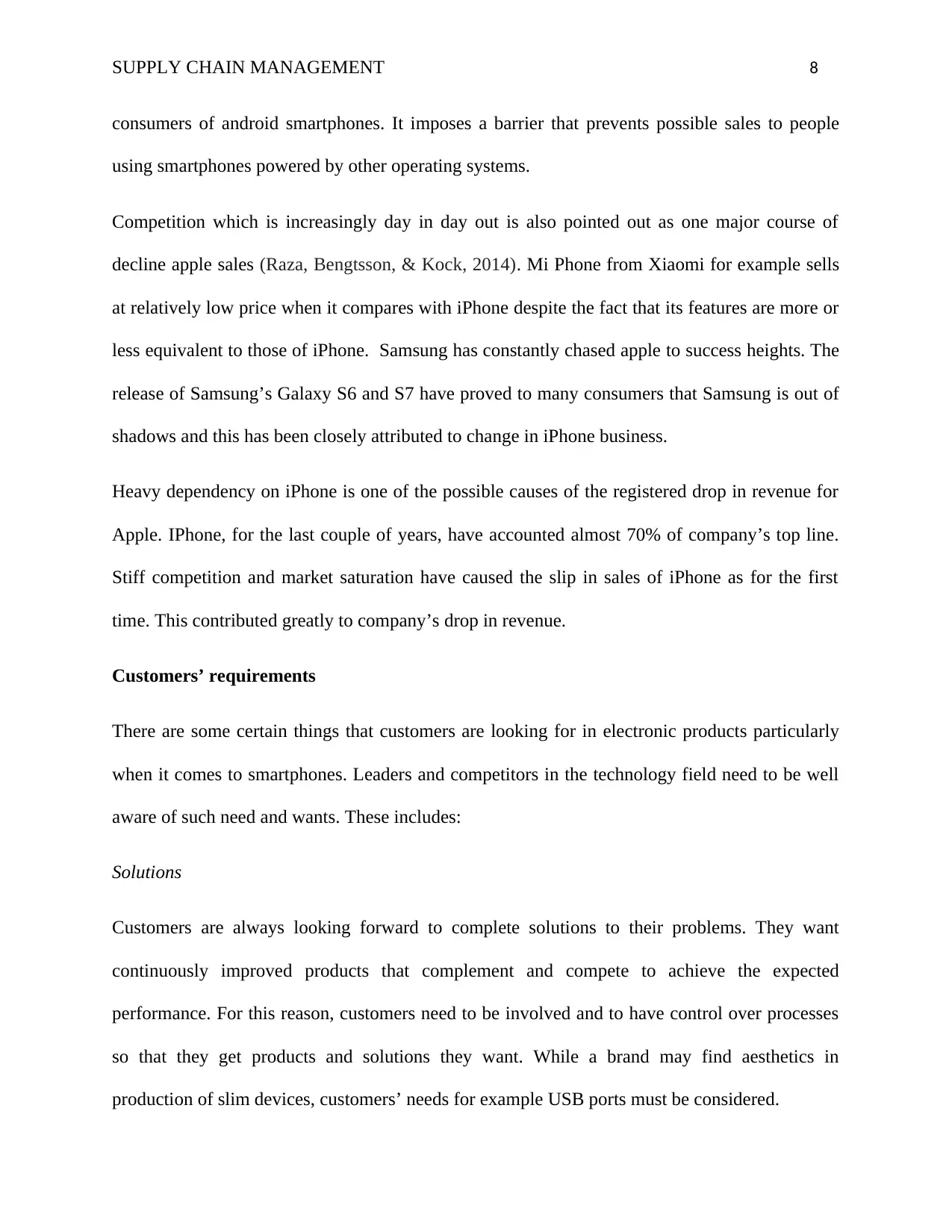
SUPPLY CHAIN MANAGEMENT 8
consumers of android smartphones. It imposes a barrier that prevents possible sales to people
using smartphones powered by other operating systems.
Competition which is increasingly day in day out is also pointed out as one major course of
decline apple sales (Raza, Bengtsson, & Kock, 2014). Mi Phone from Xiaomi for example sells
at relatively low price when it compares with iPhone despite the fact that its features are more or
less equivalent to those of iPhone. Samsung has constantly chased apple to success heights. The
release of Samsung’s Galaxy S6 and S7 have proved to many consumers that Samsung is out of
shadows and this has been closely attributed to change in iPhone business.
Heavy dependency on iPhone is one of the possible causes of the registered drop in revenue for
Apple. IPhone, for the last couple of years, have accounted almost 70% of company’s top line.
Stiff competition and market saturation have caused the slip in sales of iPhone as for the first
time. This contributed greatly to company’s drop in revenue.
Customers’ requirements
There are some certain things that customers are looking for in electronic products particularly
when it comes to smartphones. Leaders and competitors in the technology field need to be well
aware of such need and wants. These includes:
Solutions
Customers are always looking forward to complete solutions to their problems. They want
continuously improved products that complement and compete to achieve the expected
performance. For this reason, customers need to be involved and to have control over processes
so that they get products and solutions they want. While a brand may find aesthetics in
production of slim devices, customers’ needs for example USB ports must be considered.
consumers of android smartphones. It imposes a barrier that prevents possible sales to people
using smartphones powered by other operating systems.
Competition which is increasingly day in day out is also pointed out as one major course of
decline apple sales (Raza, Bengtsson, & Kock, 2014). Mi Phone from Xiaomi for example sells
at relatively low price when it compares with iPhone despite the fact that its features are more or
less equivalent to those of iPhone. Samsung has constantly chased apple to success heights. The
release of Samsung’s Galaxy S6 and S7 have proved to many consumers that Samsung is out of
shadows and this has been closely attributed to change in iPhone business.
Heavy dependency on iPhone is one of the possible causes of the registered drop in revenue for
Apple. IPhone, for the last couple of years, have accounted almost 70% of company’s top line.
Stiff competition and market saturation have caused the slip in sales of iPhone as for the first
time. This contributed greatly to company’s drop in revenue.
Customers’ requirements
There are some certain things that customers are looking for in electronic products particularly
when it comes to smartphones. Leaders and competitors in the technology field need to be well
aware of such need and wants. These includes:
Solutions
Customers are always looking forward to complete solutions to their problems. They want
continuously improved products that complement and compete to achieve the expected
performance. For this reason, customers need to be involved and to have control over processes
so that they get products and solutions they want. While a brand may find aesthetics in
production of slim devices, customers’ needs for example USB ports must be considered.
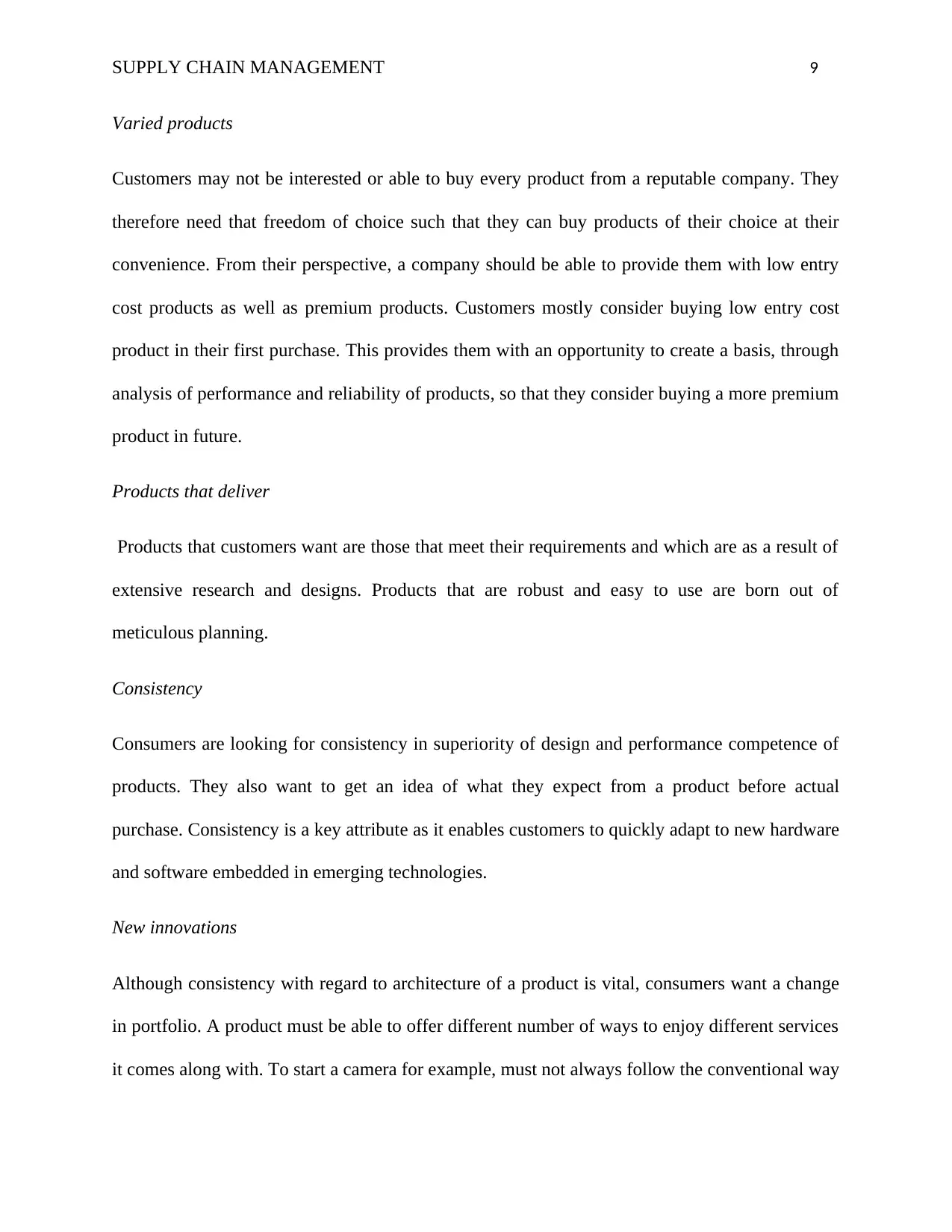
SUPPLY CHAIN MANAGEMENT 9
Varied products
Customers may not be interested or able to buy every product from a reputable company. They
therefore need that freedom of choice such that they can buy products of their choice at their
convenience. From their perspective, a company should be able to provide them with low entry
cost products as well as premium products. Customers mostly consider buying low entry cost
product in their first purchase. This provides them with an opportunity to create a basis, through
analysis of performance and reliability of products, so that they consider buying a more premium
product in future.
Products that deliver
Products that customers want are those that meet their requirements and which are as a result of
extensive research and designs. Products that are robust and easy to use are born out of
meticulous planning.
Consistency
Consumers are looking for consistency in superiority of design and performance competence of
products. They also want to get an idea of what they expect from a product before actual
purchase. Consistency is a key attribute as it enables customers to quickly adapt to new hardware
and software embedded in emerging technologies.
New innovations
Although consistency with regard to architecture of a product is vital, consumers want a change
in portfolio. A product must be able to offer different number of ways to enjoy different services
it comes along with. To start a camera for example, must not always follow the conventional way
Varied products
Customers may not be interested or able to buy every product from a reputable company. They
therefore need that freedom of choice such that they can buy products of their choice at their
convenience. From their perspective, a company should be able to provide them with low entry
cost products as well as premium products. Customers mostly consider buying low entry cost
product in their first purchase. This provides them with an opportunity to create a basis, through
analysis of performance and reliability of products, so that they consider buying a more premium
product in future.
Products that deliver
Products that customers want are those that meet their requirements and which are as a result of
extensive research and designs. Products that are robust and easy to use are born out of
meticulous planning.
Consistency
Consumers are looking for consistency in superiority of design and performance competence of
products. They also want to get an idea of what they expect from a product before actual
purchase. Consistency is a key attribute as it enables customers to quickly adapt to new hardware
and software embedded in emerging technologies.
New innovations
Although consistency with regard to architecture of a product is vital, consumers want a change
in portfolio. A product must be able to offer different number of ways to enjoy different services
it comes along with. To start a camera for example, must not always follow the conventional way
⊘ This is a preview!⊘
Do you want full access?
Subscribe today to unlock all pages.

Trusted by 1+ million students worldwide
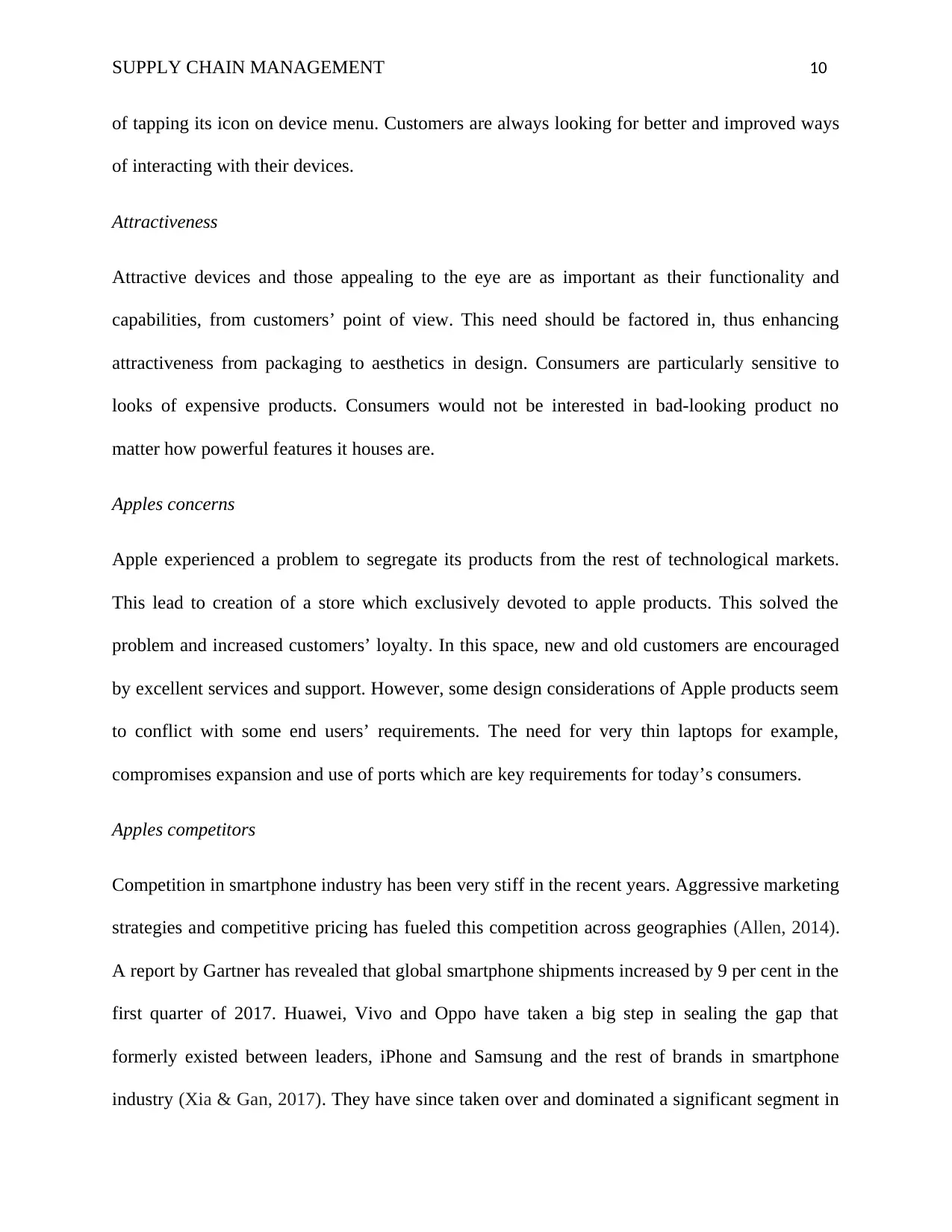
SUPPLY CHAIN MANAGEMENT 10
of tapping its icon on device menu. Customers are always looking for better and improved ways
of interacting with their devices.
Attractiveness
Attractive devices and those appealing to the eye are as important as their functionality and
capabilities, from customers’ point of view. This need should be factored in, thus enhancing
attractiveness from packaging to aesthetics in design. Consumers are particularly sensitive to
looks of expensive products. Consumers would not be interested in bad-looking product no
matter how powerful features it houses are.
Apples concerns
Apple experienced a problem to segregate its products from the rest of technological markets.
This lead to creation of a store which exclusively devoted to apple products. This solved the
problem and increased customers’ loyalty. In this space, new and old customers are encouraged
by excellent services and support. However, some design considerations of Apple products seem
to conflict with some end users’ requirements. The need for very thin laptops for example,
compromises expansion and use of ports which are key requirements for today’s consumers.
Apples competitors
Competition in smartphone industry has been very stiff in the recent years. Aggressive marketing
strategies and competitive pricing has fueled this competition across geographies (Allen, 2014).
A report by Gartner has revealed that global smartphone shipments increased by 9 per cent in the
first quarter of 2017. Huawei, Vivo and Oppo have taken a big step in sealing the gap that
formerly existed between leaders, iPhone and Samsung and the rest of brands in smartphone
industry (Xia & Gan, 2017). They have since taken over and dominated a significant segment in
of tapping its icon on device menu. Customers are always looking for better and improved ways
of interacting with their devices.
Attractiveness
Attractive devices and those appealing to the eye are as important as their functionality and
capabilities, from customers’ point of view. This need should be factored in, thus enhancing
attractiveness from packaging to aesthetics in design. Consumers are particularly sensitive to
looks of expensive products. Consumers would not be interested in bad-looking product no
matter how powerful features it houses are.
Apples concerns
Apple experienced a problem to segregate its products from the rest of technological markets.
This lead to creation of a store which exclusively devoted to apple products. This solved the
problem and increased customers’ loyalty. In this space, new and old customers are encouraged
by excellent services and support. However, some design considerations of Apple products seem
to conflict with some end users’ requirements. The need for very thin laptops for example,
compromises expansion and use of ports which are key requirements for today’s consumers.
Apples competitors
Competition in smartphone industry has been very stiff in the recent years. Aggressive marketing
strategies and competitive pricing has fueled this competition across geographies (Allen, 2014).
A report by Gartner has revealed that global smartphone shipments increased by 9 per cent in the
first quarter of 2017. Huawei, Vivo and Oppo have taken a big step in sealing the gap that
formerly existed between leaders, iPhone and Samsung and the rest of brands in smartphone
industry (Xia & Gan, 2017). They have since taken over and dominated a significant segment in
Paraphrase This Document
Need a fresh take? Get an instant paraphrase of this document with our AI Paraphraser
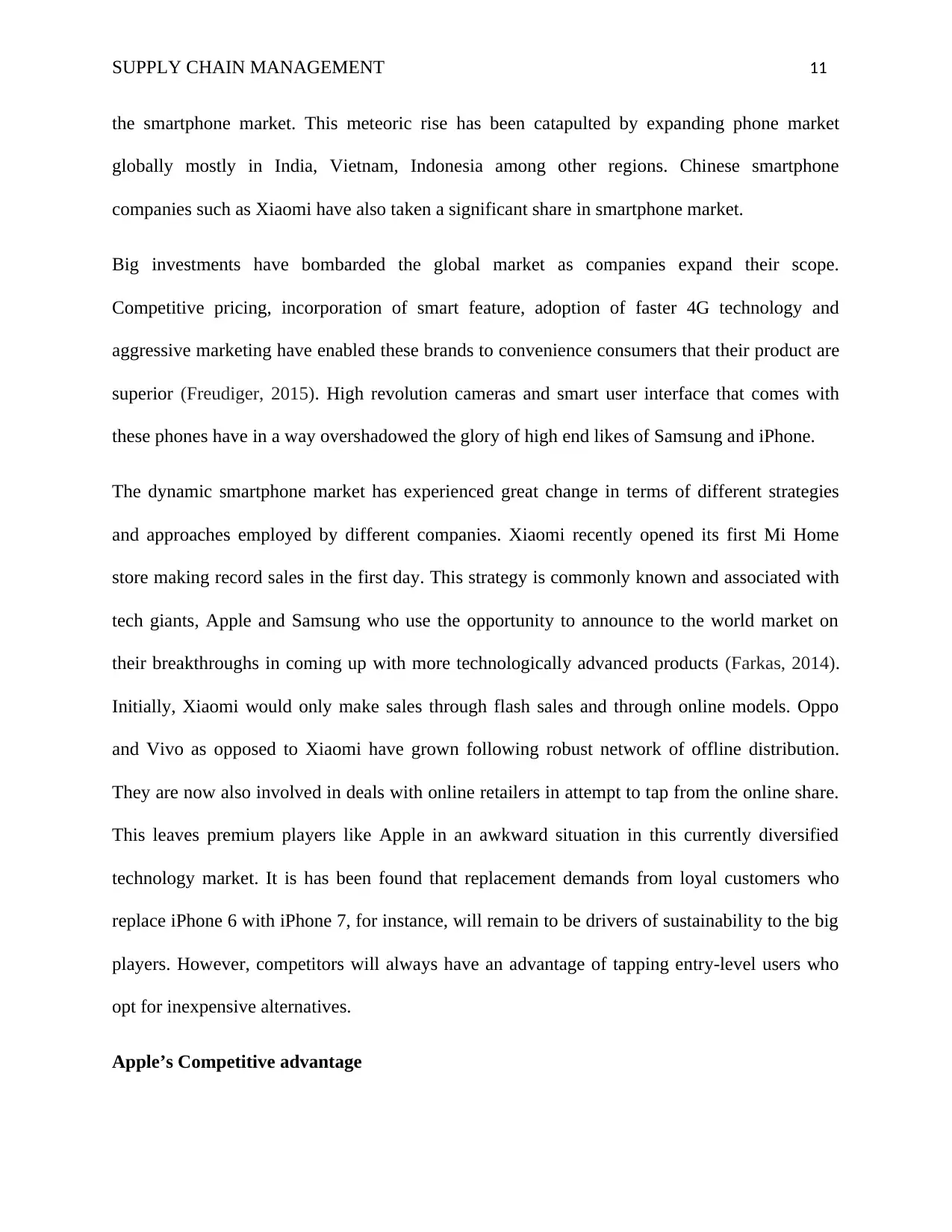
SUPPLY CHAIN MANAGEMENT 11
the smartphone market. This meteoric rise has been catapulted by expanding phone market
globally mostly in India, Vietnam, Indonesia among other regions. Chinese smartphone
companies such as Xiaomi have also taken a significant share in smartphone market.
Big investments have bombarded the global market as companies expand their scope.
Competitive pricing, incorporation of smart feature, adoption of faster 4G technology and
aggressive marketing have enabled these brands to convenience consumers that their product are
superior (Freudiger, 2015). High revolution cameras and smart user interface that comes with
these phones have in a way overshadowed the glory of high end likes of Samsung and iPhone.
The dynamic smartphone market has experienced great change in terms of different strategies
and approaches employed by different companies. Xiaomi recently opened its first Mi Home
store making record sales in the first day. This strategy is commonly known and associated with
tech giants, Apple and Samsung who use the opportunity to announce to the world market on
their breakthroughs in coming up with more technologically advanced products (Farkas, 2014).
Initially, Xiaomi would only make sales through flash sales and through online models. Oppo
and Vivo as opposed to Xiaomi have grown following robust network of offline distribution.
They are now also involved in deals with online retailers in attempt to tap from the online share.
This leaves premium players like Apple in an awkward situation in this currently diversified
technology market. It is has been found that replacement demands from loyal customers who
replace iPhone 6 with iPhone 7, for instance, will remain to be drivers of sustainability to the big
players. However, competitors will always have an advantage of tapping entry-level users who
opt for inexpensive alternatives.
Apple’s Competitive advantage
the smartphone market. This meteoric rise has been catapulted by expanding phone market
globally mostly in India, Vietnam, Indonesia among other regions. Chinese smartphone
companies such as Xiaomi have also taken a significant share in smartphone market.
Big investments have bombarded the global market as companies expand their scope.
Competitive pricing, incorporation of smart feature, adoption of faster 4G technology and
aggressive marketing have enabled these brands to convenience consumers that their product are
superior (Freudiger, 2015). High revolution cameras and smart user interface that comes with
these phones have in a way overshadowed the glory of high end likes of Samsung and iPhone.
The dynamic smartphone market has experienced great change in terms of different strategies
and approaches employed by different companies. Xiaomi recently opened its first Mi Home
store making record sales in the first day. This strategy is commonly known and associated with
tech giants, Apple and Samsung who use the opportunity to announce to the world market on
their breakthroughs in coming up with more technologically advanced products (Farkas, 2014).
Initially, Xiaomi would only make sales through flash sales and through online models. Oppo
and Vivo as opposed to Xiaomi have grown following robust network of offline distribution.
They are now also involved in deals with online retailers in attempt to tap from the online share.
This leaves premium players like Apple in an awkward situation in this currently diversified
technology market. It is has been found that replacement demands from loyal customers who
replace iPhone 6 with iPhone 7, for instance, will remain to be drivers of sustainability to the big
players. However, competitors will always have an advantage of tapping entry-level users who
opt for inexpensive alternatives.
Apple’s Competitive advantage
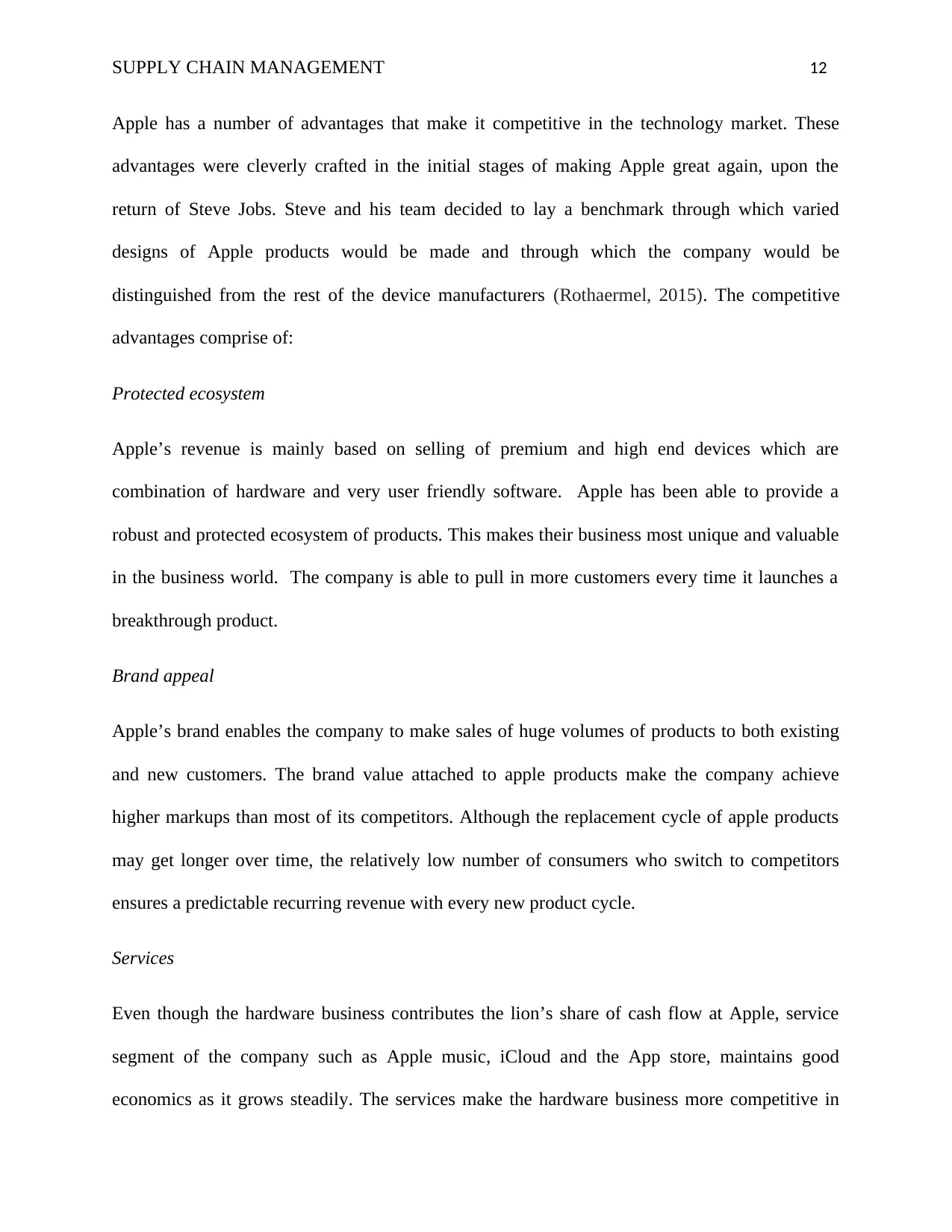
SUPPLY CHAIN MANAGEMENT 12
Apple has a number of advantages that make it competitive in the technology market. These
advantages were cleverly crafted in the initial stages of making Apple great again, upon the
return of Steve Jobs. Steve and his team decided to lay a benchmark through which varied
designs of Apple products would be made and through which the company would be
distinguished from the rest of the device manufacturers (Rothaermel, 2015). The competitive
advantages comprise of:
Protected ecosystem
Apple’s revenue is mainly based on selling of premium and high end devices which are
combination of hardware and very user friendly software. Apple has been able to provide a
robust and protected ecosystem of products. This makes their business most unique and valuable
in the business world. The company is able to pull in more customers every time it launches a
breakthrough product.
Brand appeal
Apple’s brand enables the company to make sales of huge volumes of products to both existing
and new customers. The brand value attached to apple products make the company achieve
higher markups than most of its competitors. Although the replacement cycle of apple products
may get longer over time, the relatively low number of consumers who switch to competitors
ensures a predictable recurring revenue with every new product cycle.
Services
Even though the hardware business contributes the lion’s share of cash flow at Apple, service
segment of the company such as Apple music, iCloud and the App store, maintains good
economics as it grows steadily. The services make the hardware business more competitive in
Apple has a number of advantages that make it competitive in the technology market. These
advantages were cleverly crafted in the initial stages of making Apple great again, upon the
return of Steve Jobs. Steve and his team decided to lay a benchmark through which varied
designs of Apple products would be made and through which the company would be
distinguished from the rest of the device manufacturers (Rothaermel, 2015). The competitive
advantages comprise of:
Protected ecosystem
Apple’s revenue is mainly based on selling of premium and high end devices which are
combination of hardware and very user friendly software. Apple has been able to provide a
robust and protected ecosystem of products. This makes their business most unique and valuable
in the business world. The company is able to pull in more customers every time it launches a
breakthrough product.
Brand appeal
Apple’s brand enables the company to make sales of huge volumes of products to both existing
and new customers. The brand value attached to apple products make the company achieve
higher markups than most of its competitors. Although the replacement cycle of apple products
may get longer over time, the relatively low number of consumers who switch to competitors
ensures a predictable recurring revenue with every new product cycle.
Services
Even though the hardware business contributes the lion’s share of cash flow at Apple, service
segment of the company such as Apple music, iCloud and the App store, maintains good
economics as it grows steadily. The services make the hardware business more competitive in
⊘ This is a preview!⊘
Do you want full access?
Subscribe today to unlock all pages.

Trusted by 1+ million students worldwide
1 out of 17
Related Documents
Your All-in-One AI-Powered Toolkit for Academic Success.
+13062052269
info@desklib.com
Available 24*7 on WhatsApp / Email
![[object Object]](/_next/static/media/star-bottom.7253800d.svg)
Unlock your academic potential
Copyright © 2020–2025 A2Z Services. All Rights Reserved. Developed and managed by ZUCOL.





